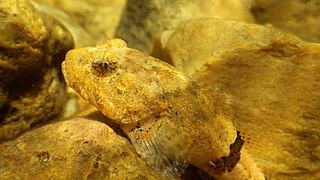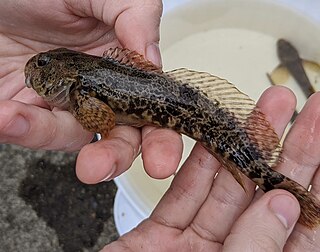
The spoonhead sculpin is a species of freshwater ray-finned fish belonging to the family Cottidae, the typical sculpins. This species is widespread in northeastern North America.

The lake chub is a freshwater cyprinid fish found in Canada and in parts of the United States. Of all North American minnows, it is the one with the northernmost distribution. Its genus, Couesius is considered monotypic today. The genus was named after Elliott Coues, who collected the holotype specimen.

The Arctic lamprey, also known as the Japanese river lamprey or Japanese lampern, is a species of lamprey, a jawless fish in the order Petromyzontiformes. It inhabits coastal freshwater habitat types in the Arctic. Some populations are anadromous, spending part of their lives in the ocean. It is the most common and widespread lamprey in the Arctic region.

The deepwater sculpin is a species of freshwater fish in the family Cottidae of order Scorpaeniformes. It is a glacial relict, native to a limited number of deep, cold lakes in Canada and the United States.

The mottled sculpin is a species of freshawater ray-finned fish belonging to the family Cottidae, the typical sculpins. This species has a wide but scattered North American distribution.

The Pacific staghorn sculpin is a species of marine ray-finned fish belonging to the family Cottidae, the typical sculpins. This species is found in the eastern Pacific Ocean. It is the only species in the monospecific genus Lepidocottus.

The European bullhead is a freshwater fish that is widely distributed in Europe, mainly in rivers. It is a member of the family Cottidae, a type of sculpin. It is also known as the miller's thumb, freshwater sculpin, common bullhead, and cob.

Eldon's galaxias is an endangered galaxiid fish endemic to New Zealand. One of several fishes in the genus Galaxias found in Central Otago, it has a very small home range and is at risk of being driven to extinction by trout introduced for recreational fishing.

The red Irish lord is a species of marine ray-finned fish in the family Agonidae. It is found in the northern Pacific Ocean, from Russia to Alaska and as far south as Monterey Bay. It is a distinctly red fish, with brown, yellow, white, and black mottling, that is generally around 30 cm (12 in) long, though specimens can grow to up to 51 cm (20 in) in length. German naturalist Wilhelm Gottlieb Tilesius formally described it in 1811. Carnivorous, it hides camouflaged among rocks on the ocean floor and lashes out to seize its prey—crabs, fish and shrimp.

The alpine bullhead or Siberian bullhead is a species of freshwater fish in the family Cottidae of sculpins. It is found in China, the Czech Republic, Denmark, Finland, Germany, North Korea, Moldova, Norway, Poland, Romania, Russia, Slovakia, Sweden, and Ukraine. This fish is listed as being of "Least Concern" by the IUCN.

The fourhorn sculpin is a species of ray-finned fish belonging to the family Cottidae, the typical sculpins. This species has a Holarctic distribution and can be found in marine, brackish and fresh waters.

Semotilus atromaculatus, known as the creek chub or the common creek chub, is a small minnow, a freshwater fish found in the eastern US and Canada. Differing in size and color depending on origin of development, the creek chub can usually be defined by a dark brown body with a black lateral line spanning horizontally across the body. It lives primarily within streams and rivers. Creek chubs attain lengths of 2-6 inches with larger specimens of up to 12 inches possible. The genus name Semotilus derives from the Greek word sema, and atromaculatus comes from the Latin word "black spots".

The johnny darter is a species of freshwater ray-finned fish, a darter from the subfamily Etheostomatinae, part of the family Percidae, which also contains the perches, ruffes and pikeperches. It is native to shallow waters throughout North America east of the Rocky Mountains.

The banded sculpin is a freshwater fish dwelling mostly in small to moderate sized streams in areas of swift current. Young and juvenile C. carolinae can mainly be found in pools, riffles, and other shallow habitats while adults tend to prefer deeper waters. C. carolinae primarily eats insects and insect larvae, but their large mouths enable them to eat prey nearly as large as themselves, including other sculpin. To prevent predation, including by other fish, the color and pattern of the sculpin tends to match its environment. Most Cottus carolinae are mottled brown with dark vertical banding and usually reach about three inches in length. They have a broad head which rather quickly narrows into a slim body, giving them the appearance of a tadpole reaching adulthood.

The eastern elliptio is a freshwater mussel in the Unionidae family, native to Canada and the United States. It is a bivalve member of the phylum Mollusca. Not only is it found in Canada and the United States, but it is frequently the most abundant species of mussel found in its home waterways. It is the most common mussel in the Delaware River and the most common mussel found in the state of New Hampshire and Vermont. It can be found in the substrate at the bottom of lakes, ponds and rivers. Size is variable, but can reach up to 13 centimetres (5.1 in) in length.

Percopsis omiscomaycus, also known as the trout-perch, the grounder or the sand minnow, is one of two species in the family Percopsidae. Its name comes from the Greek root words perc, meaning perch and opsi meaning appearance. The species name omiscomaycus is thought to be derived from a Native American word meaning trout. These are freshwater fish that prefer clear to slightly turbid water, and are found in rivers and lakes throughout North America. They are a generally small fish found in deep waters by day, but which migrate to shallower waters at night.They are most often seen washed up on beaches and are rarely seen alive or correctly identified. The trout-perch possess characteristics similar to both the trout and the perch. They are an important source of food for many predator fish such as walleye, northern pike, and lake trout. They are not a major human fishery, but are occasionally used as a bait fish.

The Coastrange sculpin is a freshwater sculpin of the genus Cottus. They are commonly found near the ocean in western North America, namely Canada and the United States. It is also known as the Aleutian sculpin.

The prickly sculpin is a species of ray-finned fish belonging to the family Cottidae, the typical sculpins. It is native to the river drainages of the Pacific Slope of North America from Seward, Alaska south to the Ventura River of Southern California. It extends east of the Continental Divide in the Peace River of British Columbia. It has also been introduced to several reservoirs in Southern California.
The shorthead sculpin is a species of fish in the family Cottidae. Shorthead Sculpins are bottom-dwelling small fish, typically sizing around 13 to 15 cm long. They have large heads and fanlike pectoral fins. They have 7-9 dorsal spines, 15-19 dorsal soft rays, and 10-14 anal soft rays. Narrow caudal peduncle. Palatine teeth and coloration being dark brown and yellow.

The inland riffle sculpin is a species of fish in the family Cottidae. It is found in the United States, inhabiting the lower Columbia River drainage in Washington, to Morro Bay in California. It is also found in the Puget Sound drainage in Washington. It reaches a maximum length of 11.0 cm. It prefers rocky riffles of headwaters and creeks.





















